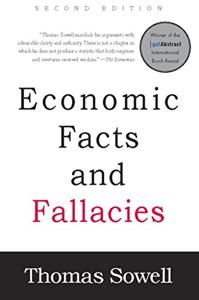
Want to learn the ideas in Economic Facts and Fallacies better than ever? Read the world’s #1 book summary of Economic Facts and Fallacies by Thomas Sowell here.
Read a brief 1-Page Summary or watch video summaries curated by our expert team. Note: this book guide is not affiliated with or endorsed by the publisher or author, and we always encourage you to purchase and read the full book.
Video Summaries of Economic Facts and Fallacies
We’ve scoured the Internet for the very best videos on Economic Facts and Fallacies, from high-quality videos summaries to interviews or commentary by Thomas Sowell.
1-Page Summary of Economic Facts and Fallacies
A Fount of Fallacies
In one old joke, two friends are talking on a busy street corner in Manhattan. Noticing the frenetic traffic, one recounts some statistics he just heard. Apparently, he says, a man gets hit by a car in the city every 20 minutes. The other friend responds with “Oh dear! How does that make him feel?” This is an example of how people often overlook important details when they hear statistical data and instead focus on what’s said about groups of people rather than individuals who belong to those groups.
This is a common fallacy that even the brightest people make. For example, it’s easy to generalize about incomes of 18- to 24-year-old young men. However, some are college grads and others are high school dropouts. That difference could be crucial when considering policy issues.
There are many economic fallacies, but the most common is the zero-sum fallacy. The assumption is that if one person gains, another loses. Sometimes this happens in economics. However, it’s important to realize that not all transactions are win-lose; they can be win-win situations as well. For example, people keep entering into economic exchanges because both parties benefit from them even if they don’t get exactly what they want out of them.
The fallacy of composition is when an individual believes that what’s true for the part is also true for the whole. For example, if you’re in a stadium and want to see better, you might stand up so that others will follow suit. However, this doesn’t help because everyone ends up being worse off than before – they can’t see any better now than when they were seated. This illustrates how what’s true for an individual may not be true for a group as a whole.
Adam Smith warned about the chess-piece fallacy. He said that it’s impossible to arrange different members of society as easily as arranging the pieces on a chess board, since people are not pawns and have minds of their own. Despite this warning, social engineers still try to control people in various ways using government programs. These schemes usually fail because they ignore human nature, and often cause unintended consequences instead of solving problems. Also, these plans tend to be expensive for taxpayers who end up paying for them anyway.
There are different types of fallacies, but they all share a common theme: the failure to think clearly. For instance, people tend to be too optimistic about the effects of certain policies. They assume that if something is good for one thing it will be good for everything else as well. However, this isn’t always true because resources are limited and choices have consequences that aren’t immediately apparent. Moreover, people often fail to consider how long a policy should last or whether it’s isolated from other events happening in society at the same time (i.e., there could be other factors contributing to an event).
If you can spot these fallacies, you’ll be able to think more clearly about some of today’s most contentious issues. It also helps to avoid the sloppy thinking that passes for wisdom in discussions of urbanization, gender, education, income and race-related issues.
Urbanization
Some people think that cities are ugly. They complain about urban sprawl and how suburbs look like a circle of hell. People who live in mansions complain about developers building cheap housing. Social critics complain about the lack of affordable housing in the city, which causes crime to rise. Taxpayers don’t want more highways because they believe that traffic will only get worse, causing congestion. Urban community leaders also fear that upwardly mobile workers will leave the city for better jobs elsewhere, which would cause them to lose their tax base.





